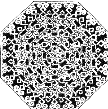|
|
Cotton warp and weft are used in Kerman rugs. Since cotton is more stable than wool against loom tension, so the flexibility and finally loosening of warps are prevented. Weft is cotton, too.
In local term, thick weft is called "Toun" and thin weft "Cocoun".
After warp winding, each 160 warps up to the next 160 warps are marked and signed. Warp winding wage is also paid on this, which in local term is called "hundred sign".
In Kerman rugs three wefts are used, instead of one or two, which are knotted over each other in every wale. First and third wefts have the same thickness and are rather thinner than warp. Middle weft is thinner than all wefts, used in weaving centers. By entrance of Tabriz weavers' culture to Babak city, near Kerman, this type of weft became common.
First, weft is immediately put over each wale of knots, then warps are moved forward, backward or reverse and then thin weft is passed. After that, warps are unfastened and third weft is passed.

|
|

